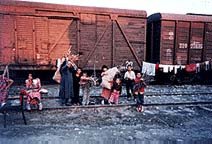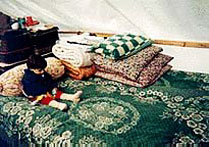|

Spring 1994 (2.1)
Page 25
Refugee Self
Portraits
An Analysis
by Betty Blair
As our staff started preparing
this issue about "Refugees" and making plans to go
to Azerbaijan in October, we worried about bringing back stereotypical
shots of distraught refugees standing around staring blank-eyed
into our cameras. (See: "Self-Portraits:
Refugees Portray Their Own World", AI 5.1, Spring, 1997)
After all, our theme was a subject many people, particularly
in the United States, had "turned off" and "tuned
out"-the plight of the homeless that we see all around us
on our streets, in our newspapers, magazines, and on television.
How could we capture a wide range of their experiences, when
we knew we wouldn't be able to stay very long in the camps?
And if we couldn't get good
photos, who could? Would the refugees themselves be able to?
What if we could find a way to put them in complete control to
decide what they wanted to show the world about their daily experiences?
Would there be a different set of dynamics at work when people
whom they knew, trusted, and with whom they had shared so many
difficult days, took the photos?
We decided to try it. And so it was, we loaded up with "disposable
cameras"-Fuji's "Outdoor QuickSnap", 35 mm, 27
exposures and headed off for Baku. (Fuji has the only color processing
lab in Baku.)
When we arrived, some Azerbaijanis expressed doubts that our
project would work. "The refugees will sell the cameras.
They'll disappear," they warned us. We decided to take the
risk. Actually, the opposite turned out to be true. On the third
day after we had distributed the cameras, when we arrived later
than hour promised to pick the cameras up, the refugees worried
that we had forgotten them. Needless to say, every single camera
was returned and the rapport that we developed is a story in
itself which will never be forgotten.
Actually, we didn't realize how rare it is for Azerbaijanis to
own cameras. Photos are quite rare and, therefore, highly prized.
And it was to these people who, perhaps, had never before in
their lives even held a camera in their hands that we entrusted
our project.
The following pages, entitled "Self Portraits" are
the work of five refugee "photographers"-two men, Farhad
and Bakhshayesh, and three women, Rahela, Farida, and Yegany,
in three different locations near Barda-in a forest, an open
field alongside a highway, and amidst some boxcars parked on
a railyard siding.
Most of the refugees living in this central region of Azerbaijan
had escaped from the city of Agdam three months earlier (July).
For many of them, Barda was not the first place they had settled
when they fled their homes; some had been wandering in the region
for the past two years.
Barda's population under ordinary circumstances is 125,000. Now
90,000 more people have flooded into the region. Resources and
support services are incredibly stretched. The newcomers have
settled any where they think life can sustain them-in buildings
such as hostels, schools, orphanages and, now, in open fields,
forests and box cars. Tragically, it may not be their last move.
Even now as I write this article the last days of December, Armenian
forces have begun their attack on Barda. If they succeed as they
have in so many regions so often in the past, displacement of
200,000 people will be absolutely catastrophic.
The Results
When all the cameras were collected,
film processed and photos studied and compared, we began to see
patterns emerge that are significant to understanding the conditions
under which refugees are surviving these incredible circumstances.
Apart from the perceptive glimpse of their lives that they show
us, here are a few of the patterns we identified:
1 The
Importance of Kinship and Friendship. One of the most revealing
characteristics of these photos is the very strong relationships
which they display, both via kinship or friendship. A great deal
of affection is evident in the photos-the proximity of people
to each other. The fear, uncertainty and mental distancing that
are so typical in photos of refugees has been replaced by an
aura of love and trust. Kinship and friendship is the absolute
basis upon which survival depends, not only for the acquisition
of daily needs, but for the mental stamina and daily decisions
that must be made.
2 Ratio
of women and children to men. We distributed the cameras equally
between men and women, yet, the majority of photos show women
and children. Comparatively speaking, there are far more women
in the camps than men. The men are at war, have been taken hostage,
killed, or died of heart attacks or trying to find work.
In terms of family size, the national average in Azerbaijan is
about four children per family though Baku families stop at one
or two. In the countryside, families of seven, eight, and nine
children are not uncommon. Statistics show that one out of ten
refugees is a child under the age of five. The frequency of photos
of children also show how central children are in these peoples'
lives.
3 Differentiation of labor by gender.
Even under these unusual circumstances, it is still the women
who are intensely burdened with necessities of living-the preparation
of food, gathering of water, rearing children, cleaning. While
the women were constantly busy, men often told us they had "nothing
to do." (Of course, "nothing" might have meant
salaried tasks).
4 Life
outdoors. These photos were taken in October when it was still
"sweater weather". But as the tents often provided
so little space except for sleeping, much of the food preparation
took place outside. The winter will add its own complications
of having to carry on so many of these tasks inside those cramped
living spaces.
5 Theme
Repetition. Ideas that are repeated over and over in the photos
indicate the importance of that issue. That's exactly what we
found with the trains where 20% of the shots in that bleak landscape
dealt with photos of people stooping under box cars. In order
to get to their only source of water, refugees had to bend under
trains on five sidings. Obviously, carrying heavy buckets of
water was not viewed as an easy task.
In summary, these Self Portraits taken collectively show the
vitality, self dignity, ingenuity, generosity and humanity of
these people. Their portrayal urges us to re-examine our concept
of refugees, not to view them as pathetic, unkempt, dirty, ignorant,
helpless creatures that are to be pitied but as human beings,
just like you and me, who just happen to be trapped in a set
of tragic circumstances, which, hopefully, will end soon.
From Azerbaijan International
(2.1)
Spring 1994.
© Azerbaijan International 1994. All rights reserved.
Back
to Index AI 2.1 (Spring 1994)
AI Home Page| Features
|




